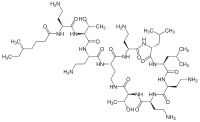
Photo from wikipedia
Simple Summary The antibiotic colistin has been used for Gram-negative bacterial infections in veterinary medicine since the 1950s, with resistance rates remaining low. However, due to the discovery of resistance… Click to show full abstract
Simple Summary The antibiotic colistin has been used for Gram-negative bacterial infections in veterinary medicine since the 1950s, with resistance rates remaining low. However, due to the discovery of resistance via transmissible plasmids in 2015, the use of colistin for animals became a subject of discussion, and actions taken resulted in a pan-European reduction of colistin sales for animal use of 76.5% between 2011 and 2020. Nevertheless, few studies evaluated real-world field data on the use patterns of veterinary use of colistin in different countries and species in Europe. A survey among 662 veterinary practitioners revealed that the majority did not use or ceased colistin use (51.9%), 33.4% had decreased their use, 10.4% stabilised their use, and 2.7% increased use. The most important indications for use of colistin were gastrointestinal diseases followed by septicaemia. Governmental/industry restrictions regarding colistin use were reported by 16% of the responding veterinarians, and of them, the most common was “use only after susceptibility testing” (57%). Abstract Polymyxin E (colistin) is a medically important active substance both in human and veterinary medicine. Colistin has been used in veterinary medicine since the 1950s. Due to the discovery of the plasmid-borne mcr gene in 2015 and the simultaneously increased importance in human medicine as a last-resort antibiotic, the use of colistin for animals was scrutinised. Though veterinary colistin sales dropped by 76.5% between 2011 to 2020, few studies evaluated real-world data on the use patterns of colistin in different European countries and sectors. A survey among veterinarians revealed that 51.9% did not use or ceased colistin, 33.4% decreased their use, 10.4% stabilised their use, and 2.7% increased use. The most important indications for colistin use were gastrointestinal diseases in pigs followed by septicaemia in poultry. A total of 106 (16.0%) responding veterinarians reported governmental/industry restrictions regarding colistin use, most commonly mentioning “use only after susceptibility testing” (57%). In brief, colistin was perceived as an essential last-resort antibiotic in veterinary medicine for E. coli infections in pigs and poultry, where there is no alternative legal, safe, and efficacious antimicrobial available. To further reduce the need for colistin, synergistic preventive measures, including improved biosecurity, husbandry, and vaccinations, must be employed.
Journal Title: Veterinary Sciences
Year Published: 2022
Link to full text (if available)
Share on Social Media: Sign Up to like & get
recommendations!